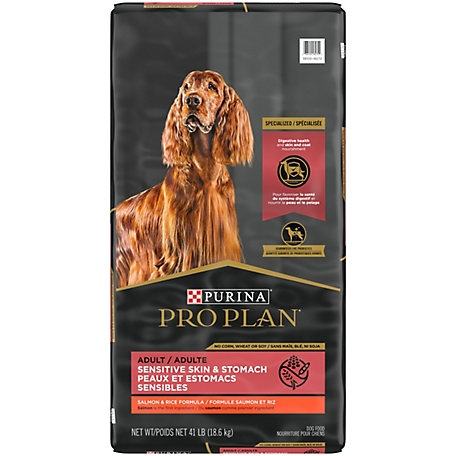Purina Pro Plan Adult Sensitive Skin and Stomach Salmon and Rice Recipe Dry Dog Food
Nurture your dog’s sensitive skin and stomach with Purina Pro Plan Sensitive Skin and Stomach Salmon and Rice Formula adult dry dog food. Nutrient-rich salmon is the first ingredient in this high protein dog food. Plus, the prebiotic fiber in this dog food for sensitive stomachs nourishes the beneficial bacteria found in your dog’s intestine for his digestive health. Antioxidants deliver immune support for your dog, while rice and oat meal provide easily digestible sources of carbohydrates. Meanwhile, fish oil for dogs rich in omega-3 fatty acids EPA and DHA helps support healthy joints, while omega-6 fatty acids and vitamin A nourish your dog’s skin and keep his coat looking healthy.
Nurture your dog’s sensitive skin and stomach with Purina Pro Plan Sensitive Skin and Stomach Salmon and Rice Formula adult dry dog food. Nutrient-rich salmon is the first ingredient in this high protein dog food. Plus, the prebiotic fiber in this dog food for sensitive stomachs nourishes the beneficial bacteria found in your dog’s intestine for his digestive health. Antioxidants deliver immune support for your dog, while rice and oat meal provide easily digestible sources of carbohydrates. Meanwhile, fish oil for dogs rich in omega-3 fatty acids EPA and DHA helps support healthy joints, while omega-6 fatty acids and vitamin A nourish your dog’s skin and keep his coat looking healthy. This dog kibble is formulated without corn, wheat, soy or artificial colors or flavors. Help keep him healthy, happy and feeling extraordinary with Purina Pro Plan Sensitive Skin and Stomach Salmon and Rice Formula adult dry dog food.
- High protein dog food formula, with real salmon as the first ingredient, made without artificial colors or flavors
- Each serving delivers fish oil for dogs rich in omega-3 fatty acids for joint health
- Dry dog food, including sunflower oil rich in omega-6 fatty acids for healthy skin and coat
- Dog kibble is rich in antioxidants to bolster your dogs healthy immune system
- Digestive care dog food with oat meal, which is easily digestible and gentle on the digestive system and a natural prebiotic fiber that nourishes specific intestinal bacteria for digestive health
Additional information
| Country of Origin | Made in USA |
|---|---|
| Breed Size | Extra Small, Small, Medium, Large, Extra Large |
| Flavor | Salmon and Rice |
| Salmon and Rice | Adult |
| Primary Flavor | Rice, Salmon |
| Manufacturer Part Number | 3810018272 |










by Connor
My dog’s hair has never looked better. She has very sensitive skin and this food has really been good for her.
by Kelly
My dog’s hair has never looked better. She has very sensitive skin and this food has really been good for her.
by Jerry
Expensive, but the dog eats it and he doesn’t throw up.
by Suzanne
I purchased this kind when the large breed sensitive skin & stomach with salmon isn’t available. My dogs do not have a hard time switching. This might actually be better since its smaller size kibble & probably digests faster. Both kinds seems to help with my labs chronic allergies & ear infections in combination with a monthly allergy shot.
by Bob
My dogs love this food.